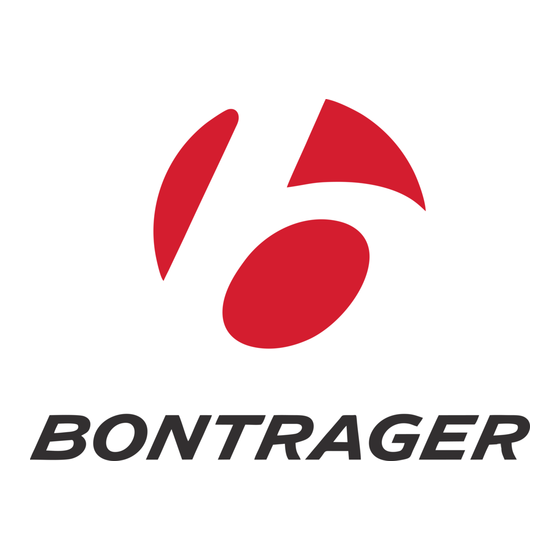
Advertisement
Quick Links
Advertisement

Summary of Contents for Bontrager Dipper Helmets
- Page 1 Dipper Helmets Owner’s Manual English...
- Page 2 Congratulations For choosing a Bontrager bicycle helmet. This helmet is constructed to meet the highest standards for performance and safety. With correct adjustment, care, and maintenance, this helmet will help your child ride safely. Read this manual before riding with your new helmet! Correct adjustment and use of this helmet is critical to safety.
- Page 3 Illustrations may not exactly match your helmet. Not all Bontrager helmets include all the listed features. This manual meets the requirements for the following standards: +U.S. Consumer Product Safety Commission 16 CFR Part 1203 +ASTM F 1447-06 +EN 1078 +AS/NZS 2063:2008...
- Page 4 Ride Safely No helmet can protect the wearer against all possible impacts. A severe impact, sharp object, improper use, or incorrect adjustment could cause conditions beyond the protection of the helmet. Check the adjustment before every ride To be effective, a helmet must fit and be worn cor- rectly.
- Page 5 Avoid chemicals The helmet may be damaged and rendered ineffec- tive by petroleum and petroleum products, cleaning agents, paints, adhesives and the like, without the damage being visible to the user. Replace an old helmet or helmet with damage The helmet is designed to absorb shock by partial destruction of the shell and liner.
- Page 6 Anything between your head and the helmet can reduce the protection. A cap, scarf, or even some high-volume hairstyles might allow the helmet to move during an impact. Barrettes, headphones, or anything else under your helmet can injure you if the helmet is impacted.
-
Page 7: Replacement Policy
Replacement Policy If your helmet is impacted within the first year of ownership, Bontrager will replace it at no charge. Ship the helmet, postage prepaid, to Bontrager customer service with a copy of your receipt and a description of the accident. We will send you a new helmet upon receipt of your crashed helmet. - Page 8 To Adjust the Left Temple Strap 1. Place the helmet on the child’s head. 2. Unlock the strap adjustor (Figure 3). 3. Slide the strap adjustor on the left temple strap (Figure 4) until the strap adjustor sits just beneath the left earlobe. 4.
- Page 9 To Adjust the Left Nape Strap 1. With the helmet off, pull the left nape strap (Figure 4) through the back of the helmet (Figure 5) to adjust the position of the left strap adjustor. 2. Put the helmet on. With the helmet correctly positioned on the head, the left strap adjustor should be just below the earlobe (Figure 6).
- Page 10 To Adjust the Right Nape Strap and Right Temple Strap 1. With the helmet off, open the right strap adjustor. 2. Slide the right strap adjustor on the nape strap until the right nape strap is the same length as the left nape strap. 3.
- Page 11 To Adjust the Chinstrap The helmet is designed to be retained by a strap under the lower jaw. The two straps hanging from the right strap adjustor that go under the lower jaw are collectively called the chinstrap (Figure 8). Make sure the chinstrap is correctly threaded through the right buckle (Figure 9).
- Page 12 The chinstrap should be located as shown in Figure 8 and should fit snugly against the bottom of your chin. If not, re-adjust. 4. To keep the chinstrap from flapping, tuck it through the rubber O-ring (Figure 9). Figure 10. Chinstrap Buckle Unfastened and Buckle Fastened...
- Page 13 Quick SetTM fit system This system works to add comfort and security to the fit of the helmet. It is self-adjusting, but to work best must be placed on the head correctly. Place the Quick Set strap (Figure 11) just below the occipital lobe, the bony protrusion at the base of the skull (Figure 12).
- Page 14 To Adjust the Fit System 1. Put the helmet on the child’s head, but do not connect the straps. 2. Position the fit system so that it is below the occipital lobe, the bony protrusion at the base of the skull. 3.
- Page 15 To Remove the Helmet While pulling lightly on the chinstrap, press on both of the recessed tabs of the buckle (Figure 13). Figure 13. Opening the Buckle To Test the Adjustments Perform each of these two tests: +Shake your head side-to-side. The helmet should not move on your head.
- Page 16 Cutting Excess Chinstrap If you choose to cut the chinstrap, leave at least 1 inch (25mm) above the buckle. A chinstrap that is too short may lead to the helmet losing its adjustment and protection. After cutting, melt the end of the chinstrap to prevent fraying. Be careful with high heat near the helmet.
-
Page 17: For Australia And New Zealand
FOR AUSTRALIA AND NEW ZEALAND: Instructions for Use and Care (a) No helmet can protect the wearer against all possible impacts. (b) The helmet is designed to be retained by a strap under the lower jaw. (c) To be effective, a helmet must fit and be worn correctly. -
Page 18: Limited Warranty
Limited Warranty See bontrager.com for detailed warranty information. Bontrager & Bontrager B-Dot are registered trademarks of Trek Bicycle Corporation. ©2010 Trek Bicycle Corporation, Waterloo, Wisconsin 53594 USA. - Page 19 bontrager.com...











Need help?
Do you have a question about the Dipper Helmets and is the answer not in the manual?
Questions and answers